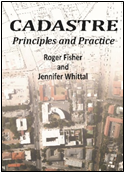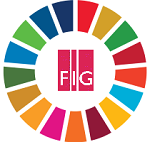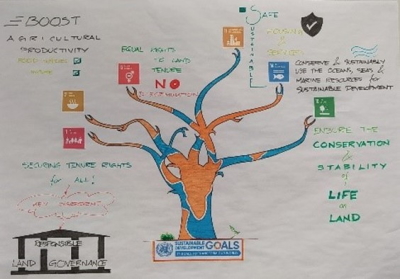News in 2022

|
FIG and the Sustainable Development Goals - Africa Regional Network
June 2022
FIG Task Force on FIG and the Sustainable Development Goals together
with the ten Commissions have worked on their role on the sustainable
development goals relevant for their Commission.
Chair of the Africa Regional Network Jennifer Whittal gives
her Statement on the sustainable development goals in relation
to the Africa Regional Network
|
 |
Jennifer Whittal, chair of the Africa Regional Network (ARN),
designed a SDG module for her students. She shares valuable
recommendations for further reading to the FIG community. Also she
shares how the FIG ARN works to advance the achievement of the SDGs.
Which SDG is most relevant for you and your daily work?
I am in the higher education sector and teach
technical surveying courses as well as cadastral surveying and land
tenure and land law. I am able to convey knowledge about the SDGs and
the role of surveyors in realising them, as well as the importance of
providing geospatial data for reporting on the SDGs. I am also able to
convey professional values that are aligned with the goals – these will
equip future professionals in meeting the SDGs within our nation, South
Africa, and the region.
In terms of research, I contribute to SDG 16 in the land
administration sector and fit-for-purpose solutions to land rights and
tenure in Southern Africa.
How do you include the SDG's in your daily work?
I have designed a module on the SDGs in my course on
land tenure and cadastral systems. Students are exposed to the SDGs and
articles specific to the SDGs in the geomatics/surveying domain of
practice:
UNDP annual report 2019,
UN GGIM Framework for Effective Land Administration,
UN Resolution
2030 Agenda for Sustainable Development, and the
Vienna Programme of Action for LLDC 2014-2024. They also read
articles about Agenda 2063 and follow a link to the Land Portal page on
Land and the SDGs where they learn about the 5 targets and 13
indicators related to land. After this, they conduct a group exercise in
designing and drawing a poster on the impact that geomatics/surveying
may have in meeting various SDGs.
Apart from the specific module on the SDGs, individual SDGs are
addressed in other modules of the land law and tenure course:
- SDG 1 No Poverty and SDG 2 Zero Hunger
- Target 1.4, Target 2.3, SDG 5 Targets 5.a.1, 5.a.2
A pro-poor focus and conscientizing students to the marginalised in
landholding (through a range of land rights and tenure options, not only
ownership) will assist in advancing this goal.
- SDG 11 Sustainable Cities and Communities
- Targets 11.1, 11.3 and 11.7
Linking land and housing provision in terms of policy and law
promotes dismantling of silos of administration of land and housing and
ensuring adequate and accessible public spaces for dignity and quality
of life.
- SDG 14 Life below water and SDG 15: Life on Land
Teaching international law and law of the sea – specifically rights
and responsibilities offshore. Educating students on the conservation of
the coastal zone through a module on coastal legislation and cadastral
practice in the coastal zone.
- SDG 16 Peace, Justice and Strong Institutions
- Targets 16.1, 16.3, 16.5, 16.6, 16.7, 16.8, 16.10, 16.a,
16.b
- Peace
- running a conflict management and resolution workshop using
UN-Habitat materials
- Justice - education regarding
- redistributive and restorative land justice – education on
the role of land reform in post-apartheid south Africa for all
citizens – acknowledging personhood aspects of property
- education on providing access to justice for all to solve
land disputes – inclusive of the informal sector, customary
communal land, backyard dwellers and labour tenants
- Strong institutions
- education in good governance particularly in relation to
land administration, land tenure and land rights – UN-Habitat,
FAO, International Land Measurement Standard Coalition, and FIG
resources are used
- education in corruption in land administration– FAO
resources are used
- empowering graduates to critique land and housing policy and
law so that they can play an engaged role as professionals in
partnership with government and civil society
- promoting the importance of government to citizen (G2C) and
citizen to government (C2G) communications – building
professional identity and competence in this area – equipping
graduates with skills to engage with government
 |
An example of a contribution to the achievement of the
SDG's
In 2020, I co-authored a book publication Cadastre: Principles
and Practice with Roger Fisher. Explaining the principles of
cadastral law and interpretation in practice, this is a
comprehensive text written for the South African practice
environment, but it is also of interest to an international
audience - in particular, chapters on international historical
development, professionalism and international law. A
progressive approach is reflected in the chapters on land law,
tenure and rights, land administration, policies and reform
initiatives. The principles conveyed in the book are informed by
good governance and good cadastral practice. As such, this book
promotes practice aligned to achieving the SDGs. |
What can FIG do to provide leadership and raise awareness on the
SDG's?
Apart from reporting at national level, there are some aspects of the
SDGs that need to be mainstreamed in surveying practices. Surveying
practices can best be reached through the member associations. Each
member association should report to the FIG on their activities in
creating awareness of the SDGs, the role of the profession in meeting
them, and also aspects of government service and private practice that
should be transformed to align with the SDGs. In particular, and in line
with our focus on Young Surveyors, we would like FIG member associations
to report on how they are transforming their Council memberships to
include Young Surveyors in leadership positions.
How the FIG ARN works to advance the achievement of the SDGs
The FIG ARN aims to the build capacity for those
affiliated with its member associations – voluntary institutions and
registration bodies of African nations. Over the years, the ARN has held
regional meetings addressing particular themes. Workshops that impacted
on the SDGs were those focussing on youth development,
professionalism/ethics, extending land rights and tenure to all, and
developing technical knowledge. Particular SDGs goals that are impacted
are 1, 4, 11, 14 and 16. Since COVID has impacted on our ability to
meet, online media is used to share relevant online courses. These aim
to build capacity through training in using geospatial technologies and
applying these in challenging contexts.
The FIG ARN has a strong partnership with the Young Surveyors
Network, whose regional expression is called the Young
Surveyors Africa Network. Driven by a vision of inclusivity and
inter-generationality, youth are mainstreamed in the ARN activities and
form part of our leadership team. The demographic bulge of young people
in Africa is an opportunity to be embraced within our profession. This
demographic dividend will only be realised by harnessing the
productivity, entrepreneurship and innovation of the youth, which, in
Africa, comprises 20% of the population. Integrating the youth in our
professional and workplace structures will provide them with
opportunities and promote resilience in the profession – we need to
overcome barriers to entry traditionally defended by the “wise ones”.
There are no specific SDGs impacted by inclusion of youth – they have an
important role to play in the profession contributing to meeting all of
the SDGs. The YSAN has continued to meet with online workshops during
COVID 19. Currently, the FIG ARN is planning to roll-out a mentoring
programme in Africa for mutual learning and growth of both the Young
Surveyors and the “Wise Ones”. Engaging the youth in Africa aligns with
the realisation of SDGs 4 (skills and entrepreneurship), 8 (decent
work), 10 (inclusion, inter-generationality, reduced inequality), and 17
(partnerships to achieve the goals).
Read more about
the Africa Regional Network here
Jennifer Whittal and Paula Dijkstra
June 2022

































